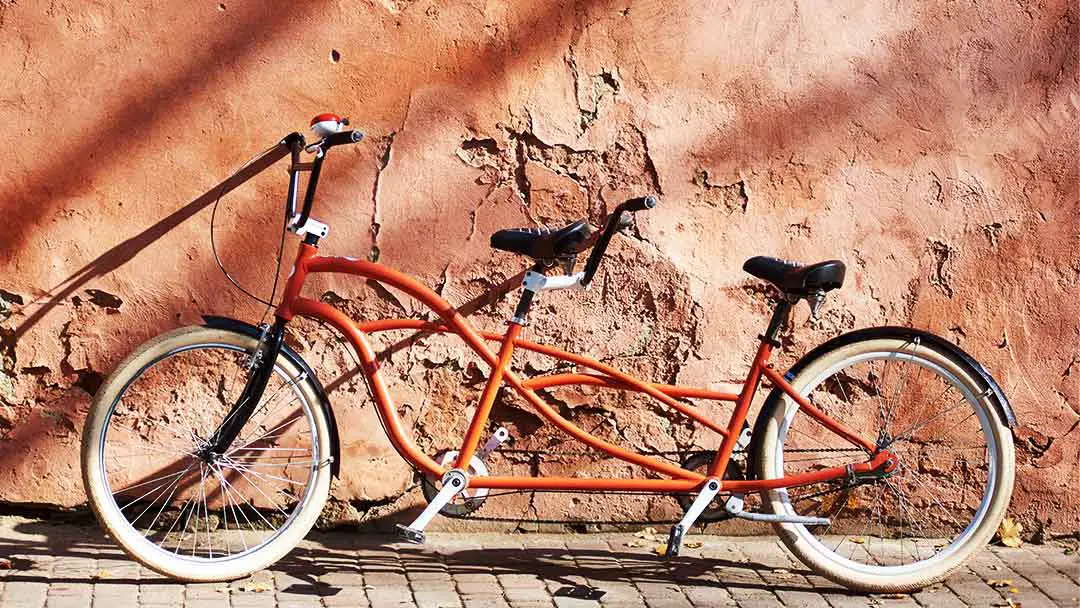Tandem Bike Touring Explained

As an Amazon Associate we earn from qualifying purchases made on our website. If you make a purchase through links from this website, we may get a small share of the sale from Amazon and other similar affiliate programs. You can read our complete legal information for more details. By using this site, you agree the information contained here is for informational purposes only. For specific medical questions, consult your doctor. NO information on this site should be used to diagnose, treat, prevent or cure any disease or condition.
Throughout the years, many have come to know and love biking as an excellent way to immerse themselves in the great outdoors, exercise, and spend quality time with friends.
If you resonate with that last part and love to hit the bike trail with friends as I do as a shared hobby, then this article is for you because today we will discuss tandem bike touring.
What is a tandem bike?
A tandem bike is designed to accommodate two riders, one in front and one in back.
More specifically, tandem bikes have two seats, two sets of pedals, and two handlebars for each rider.
That is not to say that a solo rider cannot ride these bikes in a pinch, but like many things in life, it is better with a friend!
Types of tandem bikes?
For most types of regular solo bikes, you can find a tandem counterpart from street bikes to gravel, and yes, even mountain bikes.
A well-coordinated and strong tandem team could climb a steep hill alongside their single-riding amigos.
Which type of tandem bike is right for me?
Which type of tandem bike you decide to get depends mainly on the terrain on which you plan to use it on.
If you plan on doing a lot of off-roading on your tandem tour, I recommend a gravel tandem bike, while if you are doing a majority of your team trekking on pavement or even roads, a street bike will be better suited for your style.
Here we discuss the nuances and differences between bikes and biking types:
- Touring Bike Vs. Road Bike Compared- Which Is Better?
- Can I Use a Hybrid Bike for Touring?
- Touring Bike Vs. Gravel Bike | What’s the difference?
- Bikepacking VS Touring Compared | What’s The Difference?
Tandem Bike and Wheel Size
Most tandem bikes available on the market today come with a stock wheel size of either 26-inch to 700c wheels.
The general consensus is if you find yourself far off the beaten path and are doing long stretches into the wilderness, the 26-inch would be a more comfortable bet.
On the other side of the coin, if you do a lot of riding in already paved-over state parks, the 700c could be a good fit.
Tandem Touring with Flat Handlebars
As with many bikes, tandem bikes can come with dropped and flat-style handlebars.
The flat-styled handlebars can be advantageous for trail riding and touring, as it shifts your seating into a more upright position inviting you to see the sights and enjoy a chill ride.

Tandem Touring Dropped Handlebars
The Dropped handlebars cause an increase in your aerodynamics and reduce muscle soreness on long tours.
There are benefits to both in the tandem touring arena, so this is a personal preference.
What’s the coolest part about tandem? You can afford to disagree and outfit one of each for you and your tandem teammate!
As said on Brandcycle, “A nifty advantage of tandems is being able to mix and match components to suit both riders. For example, many models sport different handlebars in the front and rear so that both riders can stretch out and move around to stay comfortable.”
Here are examples and pricing on the different handlebar types:

Riding Positions
Regarding tandem bicycle touring, there will always be two seating positions, the front and back rider, each of which has its own responsibilities to keep your bike pedaling through your journey!
Front Rider
The front rider is tasked with steering the bike, and due to this, the front rider is often referred to as the captain.
Other responsibilities of the captain include general steering, shifting, and breaking.
It is customary to place the most experienced rider in the captain’s seat.
They will also be responsible for keeping the bike balanced, leading when and where you and your partner will shift your weight during turns, and communicating with the back rider, which has slightly less visibility of incoming obstacles.
Back Rider
The back rider also referred to as the stroker or navigator, provides the power to get the bike going!
Unburdened by things like steering and shifting, the secondary rider can focus on peddling, which can be especially important when starting up from a stopped position and going uphill.
The stroker will also be responsible for keeping an even balance distribution with their front-facing partner.
This means leaning in accordance with the front rider during turns and avoiding becoming unbalanced while maintaining the speed.
Communication
During the initial ride, the two riders need to establish a line of dialogue about when to turn, upcoming potholes or bumps in the road, and speed changes.
This is especially true for extended bike tours.
Riding a tandem can be a little tricky on your first outing with your partner, but once you catch a collective rhythm and get a feel for each other’s riding style, it should be smooth peddling!
And once you feel comfortable, the back rider can take on the new role of snapping pictures, distributing snacks, and navigating!
Why tour on a tandem bike?
There are a large number of pros to touring on a tandem bike with a partner as opposed to each of you bringing your own bike.
The first pro would be the overall efficiency of bringing, maintaining, and powering one bike instead of two.
Here is a Fun fact, riding tandem cuts your likelihood of a mechanical problem prematurely, cutting your trip short in half!

Tandem Bike Pros
Here is everything I love about tandem riding!
1.) Division of labor
Tandem bikes allow for a division of labor, while as in your standard two buddies touring on two different bikes scenario, you each will be steering, braking, shifting, and peddling.
When you go tandem, you can split it 50/50, with one of you steering and braking and the other doing the majority of the peddling.
2.) Increased aerodynamics
A tandem bike saves vastly more energy than two separate bikes. Wheretheroadforks.com confirms, “Tandem bikes also create less rolling resistance”
Because two wheels are rolling instead of four, when you reduce weight, resistance, and drag on a tandem, you can save energy, causing faster, easier travel over large expanses of terrain.
So when you arrive at your destination, you will feel much less spent than you would have if you and your friend had taken different bikes.
3.) Great for kids
A tandem bike can allow you to take younger children bike touring, with the parent as the captain safely maintaining speed and balance, while your child rides secondary and peddles up a storm in the rearview.
This offers an opportunity for taking younger children touring, whereas, on their own bikes, they may require more stops and breaks.
On a tandem, they can get pulled along for a while until they are ready to resume.
4.) Great for different skill levels.
A tandem bike can be a great way to introduce someone less experienced to the world of bike riding. For example, your partner could be less coordinated and less comfortable riding alone.
A tandem can put them at ease, knowing they will have your help in peddling and balance, which may be just the push to get you guys out and partaking in this beautiful hobby together!
Cons of tandem bike touring
Here are some of the drawbacks of tandem riding.
1.) It takes some practice.
Tandem bike riding may not be as intuitive as riding solo. For example, coordinating the balance of two different people takes some team practice to understand just how to shift your weight around turns.
You also need to communicate with your partner for peak efficiency; a lack thereof could cause problems if there’s a disconnect in the mutual balance or peddling speeds.
So a tandem bike for two newcomers may differ from the bike to pick up at the last minute for a long bike tour.
I would recommend getting out and doing a couple of trial runs with your partner beforehand so that when it is time to tour, you have it down and are ready to take on the world!
2.) Less room for luggage
This is a cup half full versus cup half empty situation because some say this is a pro, as it makes you pack lighter, thus reducing your total weight and making your ride more aerodynamically friendly.
However, there is still less room for luggage when riding one bike as opposed to two, even if it is lengthier and larger.
Check out our weight distribution guide, which explains how to efficiently pack and where to put everything.
Also, we created a handy, free, printable PDF bikepacking checklist. Download it here.
3.) Brake pad stress
When carrying the weight of two people plus the bike, the breaks can get a run for their money over a couple of tours, especially if you are traveling somewhere hilly like where I live, where you regularly have to hit your breaks on the steep downhill slopes.
The brakes can heat up and fail if you are not careful, maybe even cause a blowout!
So if you do go tandem, take this bit of advice from Thetandemramble.com, “while bike packing with a tandem bicycle, you certainly need hydraulic breaks that are much more likely to be tested to its limits compared to two single bikes.”
Check out these hydraulic bike brakes to see what I’m talking about: OEM SHIMANOXT BR-BL-M8100 Bike MTB Hydraulic Disc Brake Set Front and Rear
4.) Potential trouble off-road
When going off-road tandem, you want a good amount of experience in this arena with you and your partner.
You often have to go slower off-road than you would on a solo bike.
Problems can also arise with your partner, as the secondary rider may not see an obstacle coming, and it may be difficult for the front rider to raise the alarm for ever-changing bumps and hills off-road!
Make sure you are well experienced and prepared for an off-road based, tandem bike tour. This may not be for the faint of heart (or the easily frustrated), depending on just how off-road we are talking.
5.) A captain (and the stroker) goes down with the ship.
If one of you loses balance and goes down, you both go down.
This can be nice for inclusiveness’ sake, but besides that, it could mean two possible injuries as opposed to one, which depending on how bad the ship’s sinking is and how thoroughly the crew goes down with it, could make for some problems far enough from the nearest town!

In Conclusion:
A bike tour can be one of the most magical experiences, as there is nothing like being able to explore somewhere beautiful up close and personal from the seat and pedals of a bike.
This offers something a car or a plane cannot provide, which is total immersion within the environment.
There are styles of tandem bikes for each preferred terrain, paired with wheels and tires in any combination that suits your riding style and personal preference.
Making a tandem bike the designated touring machine for you and your partner can offer many benefits, such as increased aerodynamics and efficiency in having one bike instead of two, dividing the labor between the two parties, and also offering a good riding experience for a wide array of skill levels.
Though make sure to consider that skill must develop through experience to get the most out of your tandem touring bike. Take it out for a practice run or two before you hit the road.
Make sure each person packs only the essentials, as combining them onto one bike can reduce the amount of luggage you will be able to tow, and lastly, remember to check your breaks.
All this considered, tandem bike touring can be a fantastic way to approach the task and is an even better way to get out, spend some quality time with someone you enjoy, and explore some of the immense beauty our world has to offer; happy touring!
Here are some other helpful biking articles:



